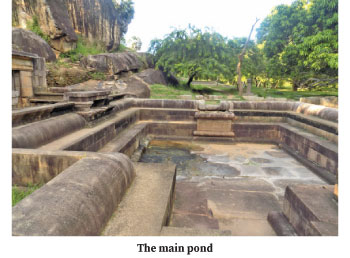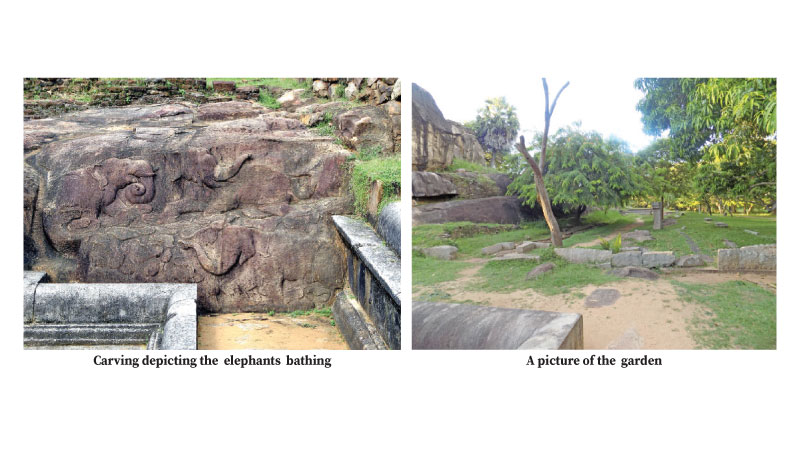The Ran Masu Uyana is a pleasure garden of the ancient royals of Sri Lanka and is found between the Tissawewa and the Isurumuniya temple in Anuradhapura.
The garden, an ideal example of ancient Sri Lanka’s garden architecture, is spread over 40 acres.
Rock sculptured bathing ponds
The Ran Masu Uyana, a protected archeological site, was mainly known for its rock sculptured bathing ponds with a sophisticated hydraulic mechanism. A subtle use of pressure enables the pumping of water from the nearby Tissa Wewa to the swimming ponds of the garden. The ponds display a clever use of technology and craftsmanship in constructing a flawless luxury swimming facility nearly 3,000 years ago.
 Even before Buddhism was introduced to Sri Lanka in the 3rd Century BCE, ponds were a definite feature of city planning. Some of these parks are the Mahamegha park set up by King Mutaseeva and the Nandana park. With the arrival of Mahinda Thera in 250 BCE, King Devanampiyatissa (250-210 BCE) donated all these parks to the Sangha.
Even before Buddhism was introduced to Sri Lanka in the 3rd Century BCE, ponds were a definite feature of city planning. Some of these parks are the Mahamegha park set up by King Mutaseeva and the Nandana park. With the arrival of Mahinda Thera in 250 BCE, King Devanampiyatissa (250-210 BCE) donated all these parks to the Sangha.
The Wessagiriya slab inscription of King Mahinda IV reveals many details of the unique constructional technique of the Ran Masu Uyana which is considered to be a marvel of ancient water management in Sri Lanka.
According to epigraphic disclosure, water through the main sluice gate was first taken to the Ran Masu Uyana and then diverted to the play house (Kadali Griha) and then to the garden pond and the water lily pond. Finally it was released to paddy fields in the surrounding area of the Isurumuniya Vihara. This park had been covered by a jungle when it was discovered by the first Commissioner of Archaeology in Ceylon, H. C. P. Bell in 1901 and renovation work was completed in 1940.
There are a number of ponds in the park. According to legend, it is believed that Prince Saliya, son of the great hero King Dutugemunu (161-131 BCE) met his future bride Asokamala who was of a lower caste known as Chandala in this garden.
Prof. Raj Somadeva said that history showed that the Ran Masu Uyana had been in use for a long time. According to him, the second major development phase seems to have begun in the 7th Century CE. During this period, several new buildings had been added to the earlier garden layout.
Plateau garden
The rocks scattered around the area were used by the architect to create the plateau garden. Two rock boulders have been connected with stone slabs at one place. The remains of a small building can also be seen on these platforms.
There is a cave like room in the middle of the park. In the centre of this cave, there are beautifully sculptured elephants bathing in a lotus pond.
Advanced building construction technology has been adapted in maintaining the natural beauty of the surroundings by joining the rocky cut crops with stone slabs and the construction of lovely ponds and bathing spots and other components needed for a park.
A major wonder of the Ran Masu Uyana is found among the rock boulders and caves away from the pools. There is a Stargate map-like chart engraved in a stone wall. It is known as the Stargate. A Stargate is believed to be a gateway between Earth and outer space through which humans are said to have roamed the universe communicating and engaging with other intelligent beings traversing the universe.
The chart is believed to be the secret code to accessing the Stargate. Facing the Stargate marking are four seats which imply that it is a chart which could be used or manipulated by four persons. You can reach the park over the bund of the Tissa Wewa and through a small path that falls to the Isurumuniya car park.









